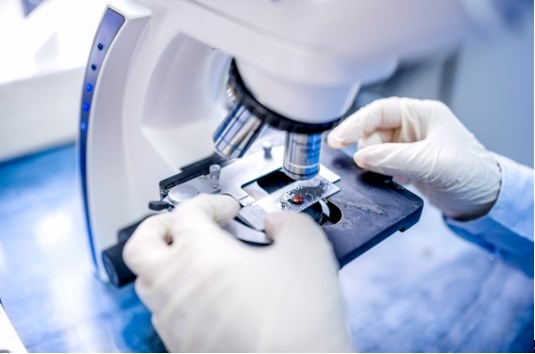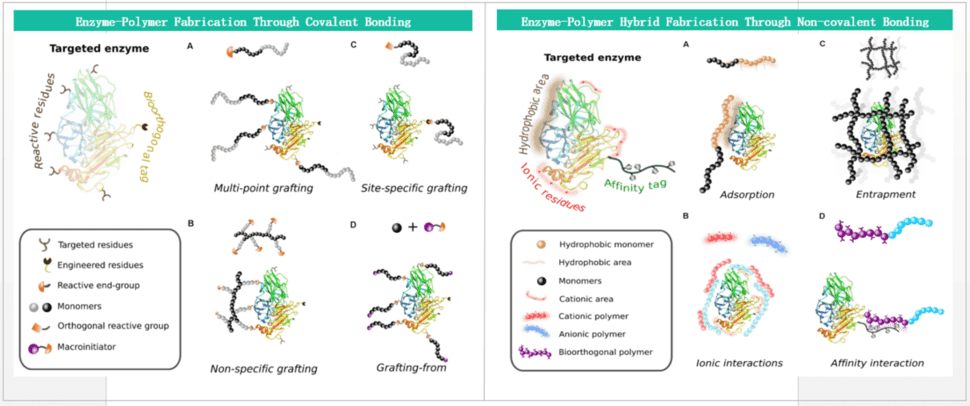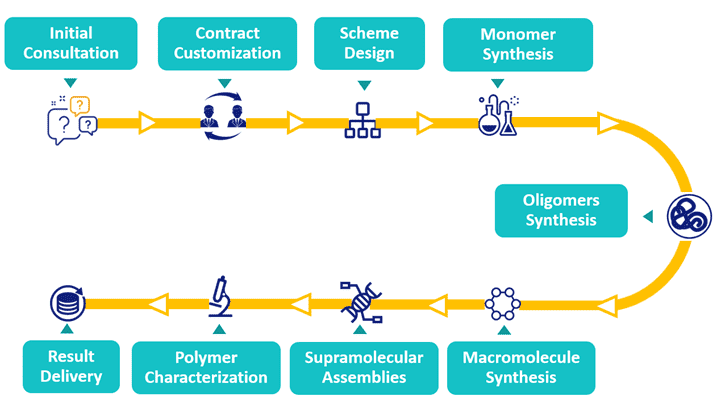
Conjugates between synthetic polymer molecules and enzymes are molecular hybrid structures in which properties of enzymes and polymer molecules are combined. Such hybrids (or conjugates) are often synthesized with the aim of modifying the physicochemical properties of an enzyme. Armed with rich experience in polymer modification, BOC Sciences provides comprehensive enzymes-polymer conjugate strategies for our clients. We specialize in the production of various biomolecules with polymer structures using advanced conjugation techniques, including custom development of polymer chains, polymer topologies, and conjugated structures. Our polymer bioconjugation services can bring better scalability and lower production cost.
Enzymes are highly specific regarding their substrate and they represent environmentally friendly biocatalysts. For clinical application, many proteins lack insolubility and stability. In vivo this results in hydrolysis, degradation, and a loss of function. Other disadvantages include short half-life in organisms and the potential of an immunogen effect. Not only the application of enzymes is drug limited, but also other applications since enzymes are sensitive to nonphysiological conditions such as extreme pH values, high temperatures, or detergents. One of the strategies for enzyme stabilization is the covalent coupling of an enzyme to an inert, biocompatible, water-soluble polymer. For this conjugation reaction, various polymers have been investigated. These include polyethylene glycol (PEG), hyaluronicacid, dextran, polyvinylpyrolidone (PVP), polyvinylalcohol (PVA), hydroxyethylstarch (HES), polyethylenimine (PEI), and polyphosphate. The stabilizing effect of such polymers on enzymes can be attributed especially to a shielding and protection of the enzyme against denaturing conditions.
 Frontiers in Bioengineering and Biotechnology. 2020, 8: 2296-4185.
Frontiers in Bioengineering and Biotechnology. 2020, 8: 2296-4185.
By far, the most commonly used polymer is the Food and Drug Administration (FDA) approved PEG. PEG can create a water shell around the enzyme which enables solubility and activity in polar organic solvents. Furthermore, the steric hindrance of PEG can prevent dissociation and autolysis of an enzyme. In enzymes-polymer conjugates, the polymers are functionalized with a group which is reactive toward one of the enzyme amino acids. Predominantly, the polymers bear an electrophilic group which reacts with a nucleophilic amino acid, such as cysteine, lysine, arginine, serine, threonine, or tyrosine. Under physiological conditions enzyme and polymer form a covalent linkage and an enzyme-polymer conjugate is formed. Such enzyme-polymer conjugates can improve the potential of enzymes for industrial applications. This is with regard to their stability enhancement, for example, polymer-conjugated enzymes are better protected against enzymatic degradation and consequently the in vivo half-time is higher compared to the native enzyme. Furthermore, the immobilization of enzymes on nanoparticles also represents another promising strategy for enzyme conjugates. Apart from the benefits in enhanced enzyme activity and stability, new vistas in biocatalysis are opened up.

Nanobiocatalysts Assembly
Nanobiocatalysts can be prepared through the attachment of enzymes via classical methods, i.e., covalent conjugation or entrapment, giving rise to hybrid units that comprise one single enzyme, or in combination with nanometric supports such as polymeric nanoparticles and capsules that can be loaded with several biomacromolecules. The main benefits from nanobiocatalysts lie in the high enzyme loadings that are achieved per weight of non-catalytic material. This fact is usually translated into a high catalytic performance of the system. Our nanobiocatalysts development customized services include:
Microstructures Enzyme-Polymer Assembly
Compared to macrostructures, microscaled polymers usually show lower diffusion issues and fairly good upscaling capacity, which makes them one of the best options for the design of biocatalytic bioreactors. In BOC Sciences, we focus our attention on enzyme hybrids fabricated with micrometric polymeric hydrogels, layer-by-layer wise assembled enzyme microparticles, crosslinking polymers, and electrospun polymeric fibers. Our microstructured enzyme-polymer hybrid assembly services include:
Enzyme-Polymer Assembly
BOC Sciences also highlights the use of macroassembled polymers into monoliths and continuous films as platforms for enzyme immobilization. The size of these materials provides the hybrids with good mechanical properties, expanding their applicability. Our macrostructured enzyme-polymer hybrid assembly services include:

References